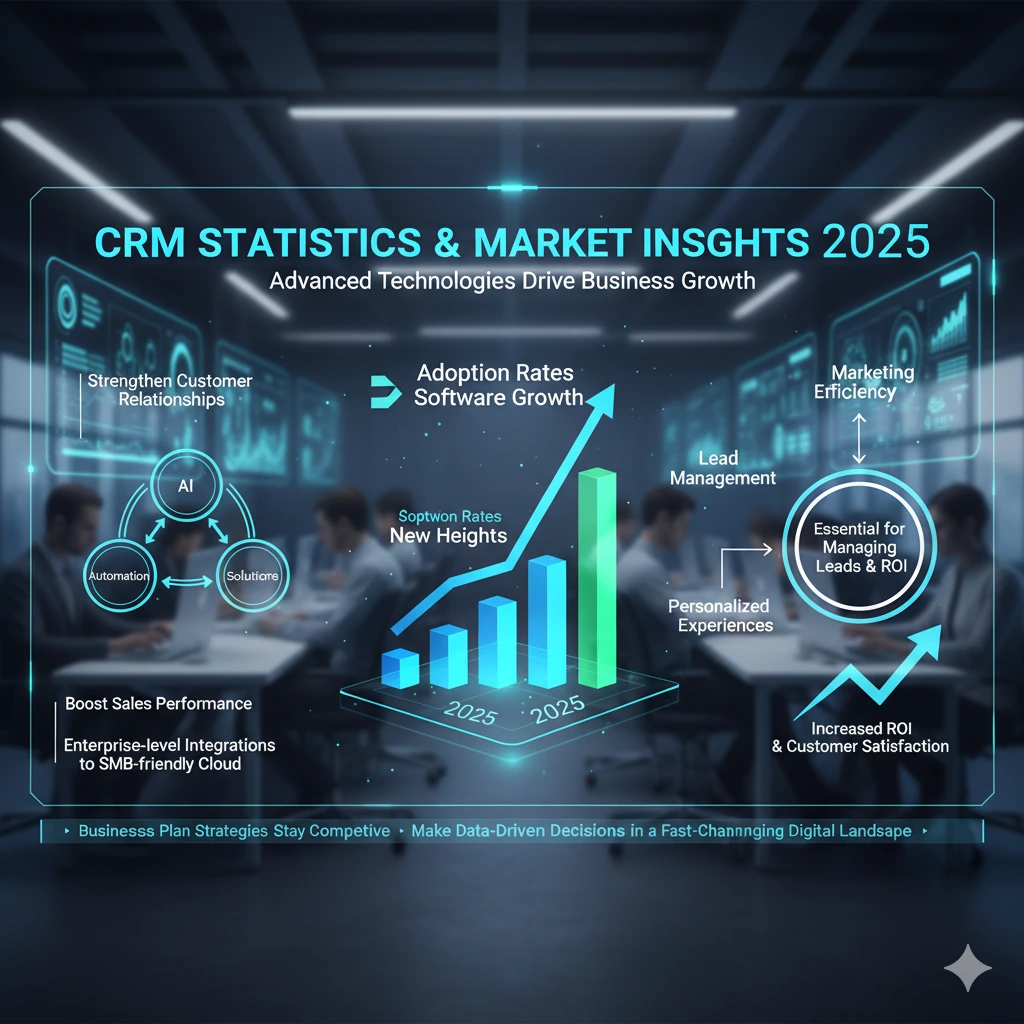
Top CRM Statistics & Market Insights 2025
Summary:
CRM Statistics & Market Insights 2025 reveal how businesses are using advanced technologies like AI, automation, and cloud solutions to strengthen customer relationships and boost sales performance. As competition grows, CRM platforms have become essential for managing leads, improving marketing efficiency, and delivering personalized customer experiences across industries.
The CRM industry in 2025 is expected to reach new heights with record adoption rates and rapid software growth. From enterprise-level integrations to SMB-friendly cloud solutions, organizations are investing in smarter CRM tools to increase ROI and customer satisfaction. These insights help businesses plan strategies, stay competitive, and make data-driven decisions in a fast-changing digital landscape.

CRM Stats & Market Trends 2025 are transforming business growth and customer interactions. Pay attention to the following trends if you're an organization looking to enhance your sales, marketing, and customer success strategy. We emphasized recent CRM trends, adoption rates, software development, and market reports in 2025 in this article and give you useful tips on how to stay ahead of the curve in a competitive landscape.
CRM Stats & Market Trends 2025 aren't merely figures, They're an indication of the paths companies are using technology to streamline efficiency, automate processes, and enhance customer experience. Small and medium-sized enterprises and big companies can gain advantage by knowing these figures in order to make intelligent choices and attain optimal ROI.
Why CRM Insights Matter in 2025

Customer relationship management is no longer a choice but a necessity for companies that have to succeed in 2025. CRM intelligence provides data-driven insight into customer behavior, sales cycle, and marketing performance.
- CRM's business success function: Every company that uses CRM software always achieves efficiency in sales and customer relationships improve. CRM solutions monitor activity, end the drudgery of manual, time-consuming work, and allow teams to focus on high-priority opportunities.
- How CRM assists sales, marketing, and customer success: CRM technology enables the sales force to identify the best prospects, the marketing organization to create targeted campaigns, and the customer success organization to sense client needs. Automation and analytics ensure an opportunity is not missed.
- Brief overview of evolution and adoption trends in the market: CRM adoption has grown over the decade from small and medium business to large business. Cloud, AI-based analytics, and mobility are transforming how companies communicate with their customers, improving ROI and efficiency in the quality field.
CRM Market Overview for 2025
Global CRM Market Size and Growth
The market for CRM is growing at a very high pace as organisations are making significant investments in customer relationship management software solutions.
Estimating the 2025 market size: The market for CRM will grow over $85 billion by 2025, driven by higher adoption across sectors.
- Percentage growth trends in terms of CAGR: The next two years will see an estimated CAGR of almost 10% driven by AI-based solutions, cloud-based deployment, and increasing sales and marketing automation demands.
- Market leaders: Market leaders are Salesforce, Microsoft Dynamics 365, HubSpot, and Zoho, but emerging industry-specific niche players are becoming popular with tailored enterprise CRM solutions.
Regional Adoption Trends
CRM adoption patterns vary by geographies depending on technology infrastructure, company size, and market maturity.
- North America, Europe, Asia-Pacific observations: The most advanced geography is North America due to technology adoption in an early stage. Europe is gradually coming up with cloud CRM growth contributing very significantly. Asia-Pacific is growing at a rapid rate with small and medium-sized businesses adopting digitization.
- Enterprise vs SMB adoption: Enterprises implement CRM to simplify complex processes and collaborate with geographically separated teams. SMBs implement cloud-based CRMs primarily for affordability, simplicity, and adaptability.
- Cloud vs On-premise CRM behavior trends: Cloud CRMs rule the roost for lower up-front investment, easy upgrades, and remote usage, whereas on-premise CRMs are still the champions in niches for highly secure industries.
CRM Adoption Statistics
Enterprise Adoption Rates
Large companies are pioneers when it comes to CRM adoption.
- Adoption of CRM by large companies: Over 90% of Fortune 500 organizations use CRM software to manage customer interaction and sales pipeline.
- Returns achieved: ROI, productivity, retention of customers, and cross-functional synergy are a few of the major advantages.
SMB Adoption Trends of CRM
An increasing number of small and medium-sized enterprises adopt CRM software.
- SMB problems: Cost, current tool integration, and technical abilities are the common issues.
- Cloud growth: Cloud-based CRM is becoming more widely adopted across many SMBs due to ease of use and lower setup expenses.
- Top small business solutions: Low-cost, scalable solutions are offered by solutions like HubSpot CRM, Zoho CRM, and Freshsales.
CRM Software Trends 2025
AI-Driven CRM Growth
Artificial intelligence is transforming CRM software by empowering it with intelligent decision-making.
- Predictive analytics: AI exposes patterns of customer behavior to uncover sales opportunity and risk of churn.
- Marketing and sales automation: Follow-up, lead scoring, and email follow-up series are automated as time is saved and productivity is boosted.
- AI-powered customer insights: Companies use AI to better segment customers, personalize communications, and improve the customer experience, taking overall CRM ROI to unprecedented levels.
Mobile CRM & Remote Work Integration
Remote working has increased the need for mobile CRM solutions.
- Employment of CRM applications: Sales and service teams can remotely update records, track calls, and handle leads.
- Impact on productivity and teamwork: Teams are able to see real-time data at their fingertips wherever they are working, facilitating spontaneous collaboration as well as timely customer interaction.
Customer Experience & CRM
CRMs are at the center of providing better customer experience (CX).
- How CRMs enhance CX: Integrated customer data via CRMs provides 360-degree visibility, enabling customized engagement.
- Personalization trends: Anticipatory communications, individualized offers, and customized recommendations are increasingly becoming popular.
- Customer retention lift: Organizations adopting CRM capability see repeat purchase increase and customer life prolongation.
Benefits of CRM Adoption in 2025
CRM adoption realizes concrete benefits:
- Greater sales and revenues: Effective lead management and automation accelerate the sales process.
- Improved lead management: Automated tracking and scoring prevent a lead from slipping through the cracks.
- Improved decision-making: Customer relationship management data are utilized to drive informed decisions.
- Improved marketing campaigns: Trends in customer behavior for CRM adoption lead to better-quality campaigns.
- Improved customer loyalty: Contextual experience and timely interaction result in increased satisfaction and retention.
Drive sales today using a PowerDialer.ai free demo, the AI CRM software increasing productivity and customer interaction.
Challenges of CRM Adoption
With advantage come challenges to companies:
- Installed base integration: It is difficult to incorporate CRM into installed business software.
- Security challenges for data: Customer data that is sensitive needs to be protected, especially in cloud-based CRM development environments.
- Implementation cost: While cloud solutions restrict up-front capital costs, widespread adoption can still be expensive.
- Adoption issues and user training: Employees need to be properly trained to use CRM hardware efficiently and maintain high adoption rates.
Top CRM Insights & Predictions for 2025
- Top-performing CRM software: Salesforce, HubSpot, Zoho, Microsoft Dynamics 365 continue to dominate the rankings with specialist platforms gaining momentum.
- Market consolidation trends: Acquisition and consolidation will be the trend where large platforms buy small CRM startups.
- Emerging technologies to redefine CRM: Machine learning, artificial intelligence, predictive analytics, and sales and marketing automation will redefine usage trends of CRM.
- PowerDialer.ai: Lead in 2025 with AI-driven CRM solutions. Book a demo of PowerDialer.ai today and revolutionize your sales game!
Conclusion
CRM Statistics & Market Trends 2025 tell us how companies can optimize customer touch points, increase sales productivity, and drive growth. Widespread adoption of AI-powered, cloud-native, and mobile CRM is transforming the landscape, and companies need to gear up accordingly. Influenced by such facts, companies can make smart decisions, drive ROI, and create world-class customer experience.
Unlock the full power of your customer relationships and sales prospects with PowerDialer.ai, subscribe to a demo today and master 2025.
FAQs
1. How large would the market for CRM be in 2025 as per the prediction?
The global CRM market will exceed $85 billion in 2025, powered by AI, cloud, and innovative automation.
2. What are the top sectors driving CRM adoption in 2025?
Some of the major business industries that are adopting CRM solutions include technology, finance, healthcare, and retail.
3. How will AI enhance CRM systems?
AI will be able to perform predictive analytics, automated repetitive tasks, customer insights, and optimization of lead scoring and segmentation.
4. What are the most significant benefits of having a CRM in 2025?
Increased sales, improved lead management, improved data-driven decision-making, improved marketing campaigns, and customer loyalty.
5. What are some of the problems organizations need to expect when adopting CRM software?
Problems are integration with existing systems, security threats for the data, extremely high cost of implementation, and training staff for implementation.
